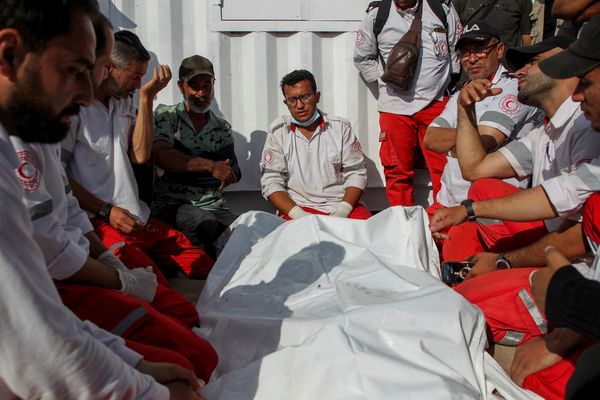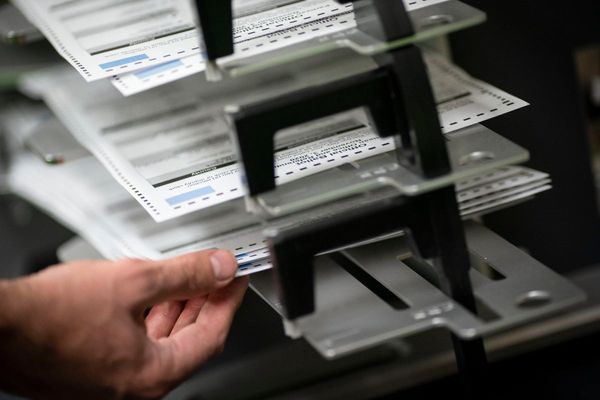The McKay House on the edge of the Campbell University campus stands out for a couple of reasons, not the least of which is its inviting front porch, the kind that would pair well with rocking chairs, lemonade and a cool breeze. It is an old house, stately, and it stands out, too, because it’s among the few athletics-related facilities on campus that doesn’t carry the shine of newness.
Few college campuses in North Carolina have undergone a more dramatic transformation than Campbell’s during the past 15 years. A new student union opened in 2020, and a medical school in 2013, but the Fighting Camels’ sports facilities have perhaps best symbolized the growth: the football stadium and basketball arena and the add-ons and renovations and upgrades all around.
The McKay House, meanwhile, has retained its original charm. The Campbell athletic department’s administration keeps its offices inside, where the age of the place has become something of a running joke. The athletic director’s office is on the first floor, straight back, and Hannah Bazemore goes to work every day with the aim of guiding Campbell’s athletics ascent.
“I know from where I sit right now, we have not reached our ceiling,” Bazemore said on a recent Wednesday morning. Outside, the sound of the marching band practicing in the distance offered a faint prelude to Campbell’s final football season in the Big South Conference while Bazmore pondered the future. “I think the possibilities are kind of endless at this point on what we can do.”
Bazemore became Campbell’s interim athletic director on July 5. Almost a month later, the university announced its impending move to the Colonial Athletic Association, one of the nation’s strongest FCS football leagues, and also one that over the years has produced its share of magic in the NCAA men’s basketball tournament.
In the CAA, Campbell saw commodities that just about every NCAA Division I school, regardless of the size or long-term aspirations, is seeking these days: stability, for one, but also an opportunity for growth. Stability, especially, has suddenly become rarer in this summer of consternation and upheaval throughout college athletics.
The news in late June of the Big Ten’s westward expansion, with the impending additions of UCLA and USC, proved stunning even in an industry long known for its unpredictability. It left rival power conferences scrambling, trying to anticipate what might be next. In the ACC, it inspired fear that the conference might be vulnerable to poaching.
More than anything, it offered more foreshadowing of where college athletics is likely headed: toward a model with more consolidation, one in which the divide between the most powerful schools and leagues, and everyone else, will become even more significant than it is already.
Apprehension has trickled down. In far less wealthy leagues, including those with schools throughout North Carolina, the turmoil in major college athletics has only served to underscore the vast gap between those at the top and those trying to climb. And here, like everywhere, most schools more closely resemble Campbell than those with $100 million athletic department budgets.
Carolina’s college culture
North Carolina, more than most states, represents a microcosm of the NCAA. There are the four ACC schools, split evenly between public and private. There are three others that play FBS football. Eleven others, including Campbell, also compete in Division I, and begin every basketball season with the dream of ending it in the NCAA tournament.
North Carolina’s 18 Division I schools are fourth-most of any state in the country. Only California (24), New York (22) and Texas (21) are home to more. College sports are baked into North Carolina’s culture, and have long become a part of its identity. And while the ACC schools garner the most attention, the state’s relationship with college athletics goes beyond Tobacco Road.
It includes fall Saturdays in Boone, where Appalachian State supporters have borne witness to the Mountaineers’ ascent from FCS power to FBS antagonist. And it includes those same Saturdays across the state in Greenville, where ECU has long embraced — and succeeded in — its role as spoiler to its more-monied in-state rivals.
It’s the Aggie-Eagle Classic, between HBCU rivals North Carolina A&T and N.C. Central, and it’s the quirky and newly-minted BBQ Bowl, between Campbell and Gardner-Webb. It’s small student bodies cramming into small gyms throughout the winter in Davidson and Elon and Buies Creek, and it’s the dream of Selection Sunday, and seeing your school’s name appear in the bracket.
And now, throughout Division I, it more and more feels like the entire enterprise has been turned on its head. It felt that way even before late June, what with the confusion surrounding name, image and likeness (NIL) and the revolving door of the transfer portal and the specter that the largest conferences might one day break away. And then the Big Ten news further changed everything.
‘Multiple levels of Division I’
It is not a question now of “if,” Jon Gilbert said recently, but “when.” He has been the athletic director at ECU since 2018, and he has seen enough over the past year or two to come to the conclusion, in his words, that sooner than later “schools will just be paying athletes directly.”
In a sense it’s already happening, said Gilbert, who during a recent interview argued that “we’re at pay-for-play now” given the reality of compensation disguised as NIL deals. Soon enough, though, he predicted that it would become more overt. That there won’t be a need to creatively package athlete salaries through cumbersome NIL deals; that players will more closely resemble employees.
“I think what we’re going to see is multiple levels of Division I,” Gilbert said, “and all the schools are going to be aligned of where they are financially, and the type of amenities that they’re providing” athletes.
That is part of the underlying motivation driving major conference realignment, after all: the desire to maximize revenue to compete in a college athletics world in which all signs point to the inevitability of direct player compensation. Gilbert, who before starting his tenure at ECU worked in high-level administrative roles at Alabama and Tennessee, foresees it happening in the next three years, he said.
“You have the NCAA Transformation Committee that’s working on deregulating the rule book,” Gilbert noted, “and so I think the freedom of the larger resource schools to spend — if and when that is voted on — I think that will be the impetus for the separation of divisions, so to speak.”
If Gilbert’s vision comes to pass, and it’s as reasonable as any other prediction about where everything is headed, it would make the top tier of college athletics — and especially the top tier of college football — a more exclusive club than it already is. And it would likely spell trouble for those outside of the power conferences, and schools like ECU and Appalachian State and Charlotte.
Those three are North Carolina’s “other” FBS schools, those that operate somewhere between Division I’s haves and have-nots. All three have had enough in recent years to spend millions on facilities upgrades, especially ones devoted to football, and yet their more modest budgets — relative to their ACC brethren — suggests an inability to compete at the highest level.
And yet the on-field results at times belie the finances: App State, Charlotte and ECU have all managed to hold their own in recent years against in-state ACC opponents. Charlotte defeated Duke at the start of last season. App State defeated UNC in Chapel Hill in 2019. ECU, since 2000, is 11-11 against Duke, N.C. State and UNC (but 0-5 against Wake Forest).
For years, ECU has proven its mettle against its wealthier in-state public school rivals. App State, meanwhile, has had nothing but winning football seasons since transitioning in 2014 to the FBS, and the Sun Belt Conference. Charlotte, which debuted its football program in 2015, has fared well enough in Conference USA to have earned an invitation to the American Athletic Conference, where the 49ers will join ECU and begin play in 2023.
It has never been easy for any of these three schools, and an increasingly-turbulent environment has only made their plights more difficult; their access to the highest level of competition more uncertain. Their shared reality is analogous to a climber traversing a mountain. The climber ascends halfway. All of a sudden, the peak continues to grow. Much of college athletics can resemble a hamster wheel, with schools sprinting to catch up and largely remaining in place.
“You’re looking way, way, way up,” said Doug Gillin, the athletics director at App State. He was referencing the ever-rising financial pinnacle at the top of FBS football, the distance that the Big Ten and SEC have put between themselves and everyone, even the ACC. “That’s happening. That’s not going to stop.”
The question, then, is one Gillin posed on his own during a recent conversation:
“Do I think we can compete in the national landscape of college football?”
His answer came in the next breath: “Absolutely.”
“We know that there’s going to be certain things that we can’t do, and we can’t keep up with,” he said. “But I just think, for us it’s really about our identity — just be the best we can be and be competitive, and make sure that we pick our spots.
In Boone, Gillin carries a different vision of the future than his colleague at ECU. Where Gilbert sees an inevitable split among Division I schools, with tiers forming based on bottom lines and budgets, Gillen does not see further separation as the ultimate end — perhaps because he’d like to see something else.
“We’ve got to figure out, ‘Where do we all fit?” Gillin said, referencing the more than 130 schools who field FBS teams. “And I don’t believe it’s separating. I don’t think it’s taking the top ‘X’ amount and going and playing in one football division. I think you’ll lose fan interest.
“I think the same could be said in basketball.”
‘The little guys’ and their place in March Madness
On a makeshift stage in Atlanta at his conference’s annual football media days last month, SEC commissioner Greg Sankey posed an ominous question that went largely unnoticed — except by those who’d be most affected by its answer.
In discussing the College Football Playoff, and whether it should include automatic bids for conference champions, Sankey wondered aloud “whether there should be any guarantee for conference champions at all.”
“Just earn your way in,” he said. “There’s something that’s healthy competitively about that and creates expectations and support around programs.”
The implications were clear. Here was Sankey, arguably the most powerful leader in college athletics, questioning the value of offering automatic playoff berths to conference champions. If that was his approach to football’s postseason, then why not basketball, too?
Sankey’s comments last month came not long after Stadium reported, earlier in July, that during a Division I Council meeting Sankey expressed interest in restructuring the tournament, and possibly making it more inaccessible for smaller schools. Earlier this month, in a story in Sports Illustrated, the potential for reorganizing the NCAA tournament became more crystallized. Sankey advocated for a “fresh look” at it, according to the magazine.
At smaller schools around North Carolina, those that must win their conference tournaments to compete in the NCAA tournament, Sankey’s recent comments have spread quickly. They’ve become the focus of office speculation and a target of ire and frustration. In an industry more and more divided by money, some fear the potential of being shut out of the NCAA’s premier event, its weeks-long postseason men’s basketball tournament.
“Yeah, I’ve got a lot of thoughts on it,” Kevin McGeehan, the Campbell men’s basketball coach, said recently. “Not all that I would want printed.”
He picked his next words carefully, praised “the charm” of March Madness and offered a stance that’s been widespread in recent days: “I think it would be foolish” to change the tournament, McGeehan said.
“Now, at the end of the day, if they just want to say, well, there’s just too many mouths to feed, so we’re not feeding your mouth, then I’m not sure what that means. But I think the reason that it stays successful is because of all the little guys.”
North Carolina’s little guys can be described as those schools that play FCS football, or no football at all, while otherwise maintaining their place in Division I. There are 11 such schools, and in a college athletics world more and more controlled by football, the absence of it, at the highest level, has further contributed to the divide.
Sankey’s commentary, his open brainstorming about whether the NCAA tournament should be changed, has added to the feeling that smaller-school athletic departments are under attack; that their place at the table, at least when it comes to access to the postseason, might be in jeopardy. In North Carolina, especially, March is a sacred month.
It has been that way for a long time, starting perhaps in the mid-1950s with those early ACC tournaments held at Reynolds Coliseum. The ACC, though, doesn’t own a monopoly on the memories. Charlotte reached the Final Four in 1977. Steph Curry first announced his national arrival as a skinny guard at Davidson in the 2008 NCAA tournament. For UNC-Wilmington supporters, fierce snow storms might always conjure thoughts of Brett Blizzard, who led the Seahawks to the second round of the 2002 tournament.
A little more than three years ago, McGeehan’s Camels, led by Chris Clemons, were one victory away from joining the little guys in the tournament. Campbell, though, suffered a five-point loss against Gardner-Webb in the Big South tournament championship game. A little more than a week later, the small town of Boiling Springs, home to Gardner-Webb, came together inside the student union to watch the NCAA tournament Selection Show.
When the Bulldogs’ name appeared during the broadcast, a large banquet room full of supporters erupted in raucous celebration. The No. 16 seed in the South Region, they led Virginia by six points days later in Columbia, South Carolina, before succumbing in the second half.
“When our team came on the court pregame, I had chills,” Chuck Burch, the Gardner-Webb athletics director, said recently, recalling the scene in Columbia. “It was so loud, and it was just beyond words that could describe how you felt about that.”
Gardner-Webb’s 2019 NCAA tournament appearance, its first and only in school history, represented the culmination of Burch’s work, years earlier, to lead the athletic department into Division I. Now, months away from retirement, he wonders where all of this is heading.
“To sit there and think that you would potentially lose that opportunity,” he said of competing for a tournament berth, “you know, that’s discouraging to me. And I hope that would not be the result of all this transformation committee moving and changing things.”
Burch, who has been in his role since 1997, feels like he’s exiting college athletics administration at the right time.
“I jokingly told a couple of my Big South colleagues at our spring meetings, I said, ‘Guys, you know, who knows what’s gonna happen with the NCAA?’” Burch said, laughing as he recalled the conversation. “I said, but one thing that I do know is I probably will not be dealing with it.”
Embracing the climb
Back at Campbell, Bazemore is only just beginning an interim tenure that she hopes turns more permanent. She has big plans should she become the university’s long term athletic director. She’d need to raise the profile and fundraising proficiency of the Fighting Camels Club, the school’s booster association. She’d need to keep pouring money into facilities.
At any level of Division I these days, standing still means falling behind. Campbell’s move to the CAA reinforces that truth, after years of program-wide success in the Big South. Relocating to the CAA, which the Camels will do next year, “is a natural move,” Bazmore said, but one that won’t be without its challenges, especially on the field and court.
“We probably won’t win an all-sports trophy in year one,” she said with a laugh.
Bazemore has spent her entire adult life at Campbell. She graduated with her graduate degree from there in 2007. She earned an MBA from there in 2009. She began working full-time in the Campbell athletic department in 2010. While the campus itself has almost been rebuilt some things remain the same. Buies Creek, like the McKay House, has retained its original charm.
Campus still blends into the surrounding farmland. Older homes still line the two-lane roads that lead into rural Harnett County. One small traffic circle, near the basketball arena, still branches off into a mini main drag, replete with a Subway, a coffee shop, a pizza place and the beloved Campus Grill, which is “home of the ‘Jacked-Up Burger,’” according to signage on the wall outside.
There on that wall, three silhouetted camels, painted onto the brick, advertise the grill’s specialties:
Cheeseburgers. Hot dogs. Fries.
There’s an innocence to that tiny strip of hangouts, and to the greater campus, and it’s easier there than it is in a lot of places to believe in what the NCAA has long tried to sell about amateurism and the purity of college sport. But then Campbell, too, has its eyes on the big-time — or at least the bigger-time. The improvements around campus offer proof.
Barker-Lane Stadium, where the Camels play football, opened in 2007. Lights came in 2012, followed by a football-centric performance center in 2015 and video board in 2016 and a new synthetic turf field in 2018, the same year Campbell began offering football scholarships. The Pope Center, where the Camels play basketball, opened in 2008, at a cost of more than $30 million, and it, too, has since received a new video board and playing surface. The baseball stadium underwent a renovation in 2017, which left it with the largest video scoreboard in the Big South.
That conference generated about $5.6 million during the 2020-21 fiscal year, according to its most recent tax return. The CAA, meanwhile, generated approximately $7 million, and Campbell’s move there will result in larger pay days. The university believes its investments in athletics have been worthwhile, especially as it relates to “just driving enrollment,” Bazemore said.
“The more we pour into athletics, it helps with recruiting,” she said, and she wasn’t talking about athletics recruiting but academic recruiting. “I think it plays a big part in our success.”
The move to the Colonial comes with the promise of greater revenue and exposure and the potential for more. Within the past 15 years two Colonial schools, George Mason and VCU, reached the Final Four in basketball before departing for other leagues. James Madison, a Colonial and FCS football power, has transitioned to the FBS and is entering its first year in the Sun Belt Conference. And so who knows what might be possible for Campbell, which has traveled a long road from its days as an NAIA school in the mid-1970s.
The only thing that’s clear now is that the university has embraced the climb, and that the unpredictable forces shaping college athletics could change the direction of the Camels’ ascent at any time. Down a short hall between Bazemore’s office and the front door in the McKay House, an old framed poster hangs on the wall that commemorates one of Campbell’s most memorable sports achievements. It’s a poster celebrating the 1992 NCAA tournament.
John Wooden signed it, with a short message to Dr. Adrian Wiggins, who was then Campbell’s president. One has to squint to see Campbell’s name on the poster but it’s there among the teams in the ‘92 field. The Camels, a No. 16 seed, made their first and only tournament appearance. These days, the memento is either a reminder of what remains possible or it’ll prove to be a relic from a time when the big schools and little ones could share the same stage.







